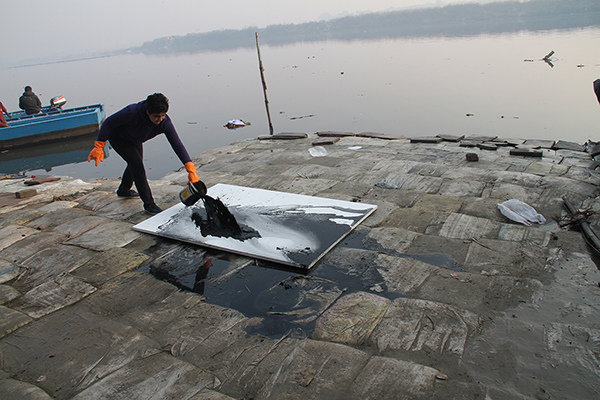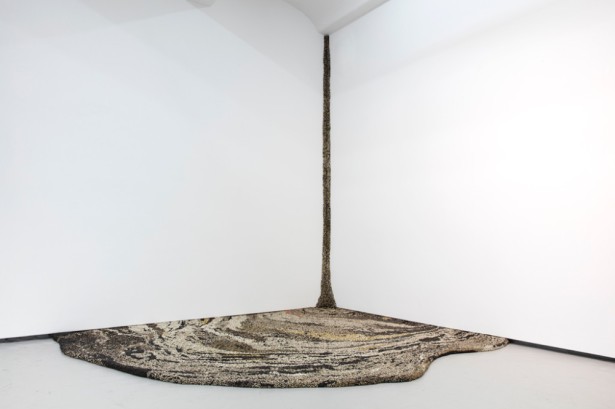
MASLEN & MEHRA in collaboration with street artists, Shuby and Delete
1 September – EXTENDED until 26th November
Hastings Museum & Art Gallery
John’s Place, Hastings TN34
Maslen & Mehra consider their more recent work to be ‘micro’. By that, they mean they are honing in on very specific political and environmental dilemmas. This requires a completely different methodology to previous work in order to explore detailed narratives. The sculptures in their current series have been based on ceramic plates researched in museums around the world. These include the Victoria & Albert and British Museums, London; Hastings Museum, UK; Mares Museum, Barcelona; the Metropolitan Museum, New York; the Archaeological Museum and the Turkish and Islamic Art Museum, Istanbul; the Asian Museum of Civilization in Singapore and the Museo Internazionale delle Ceramiche in Faenza, Italy. Maslen & Mehra fashion the sculptures from humble materials: wire and papier-mâché, completed with a decoupage technique of small tiles of archival prints. The narrative of each original plate is altered to highlight a variety of ideas tied to three themes: Cash, Clash and Climate.
The Cash series draws attention to bank bailouts; Doughnut Economics; credit culture; housing bubbles; tampon tax; quantitative easing; war as big business; the commodification of food staples; and the almost religious status that money has reached in our times. The Clash series embodies social unrest from London to Athens; Article 475; the refugee crisis; Grenfell; Greece and the Eurozone; social media to organise protests; fracking; gun control vs gun rights; and the Dakota Access Pipeline. Lastly, the Climate series highlights environmental topics such as global coral bleaching events; chronic pollution as a heavy cost for economic power in China; melting ice caps; the opposing views of climate change; El Niño; Natural Capital; and the legacy of radiation from Japan’s nuclear disaster in Fukushima. The artists have made bespoke stands for the sculptures and invited local street artists, Shuby and Delete, to add to their surfaces, responding to each theme. This exhibition at the Hastings Museum draws together pieces from the three collections for the first time, representing years of work.
The sculptures individually pose questions about political, social and economic structures but together they ask how they, in turn, relate to social unrest and environmental issues. Some themes may be familiar to the viewer such as the piece, Polarized, which confronts us with opposing slogans: ‘Global warming is a cruel hoax’ and ‘Climate can’t wait’. Others are less obvious, such as the piece Article 475 which encourages the viewer to look further if they don’t understand the reference. Faith in Fiat questions the shift from commodity money to a fiat system which is effectively a promise. Is it sustainable to have such blind faith? The largest piece in the collection, Natural Capital references a system by which natural assets (water, geology, biodiversity, soil, air) and ecosystem services (pollination by insects, recreation, natural flood defences etc.) are given a financial value. Could this alternate economic system be the key? Maslen & Mehra have created the framework Cash, Clash and Climate in order to ponder questions about the complexities of living today and they invite viewers to follow their train of thought.
Hasting Museum and Art Gallery has an extensive ceramics collection. This exhibition will be in the newly refurbished Ceramics Gallery which showcases pottery production over the past 5000 years.
Hastings Museum and Art Gallery
Telephone: 01424 451052
Or you can contact us via Twitter or Facebook
https://twitter.com/hastings_museum
https://www.facebook.com/HBC-Hastings-Museum-Art-Gallery-218155741717952/
Admission is free. We are open all year:
April – October: Tuesday - Saturday 10am – 5pm, Sunday 12noon – 5pm. Last admission 4.30pm
November – March: Tuesday - Saturday 10am – 4pm, Sunday 12noon – 4pm. Last admission 3.30pm
The Museum has full wheelchair access throughout and disabled toilet facilities.
Free parking available outside Museum, including 1 disabled parking bay.

MASLEN & MEHRA Biography
Tim Maslen (b. 1968, Australia) studied Fine Art at Curtin University, Perth and completed an MA at Goldsmiths University, London in 1997. Jennifer Mehra (b. 1970, London) studied Fine Art at City Art Institute, Sydney and the National Arts School, Australia. Mehra was a founder of VOID, an East London artists’ – run space, which staged dozens of exhibitions for four years from 1997 – 2000.
Maslen & Mehra have worked collaboratively since 2000. They are recipients of a grant award from the Arts Council of England for their ongoing work Cash, Clash & Climate (2015 – 2017). Work from this series was included in an exhibition curated by Jenni Lomax, Melanie Manchot and Brian Cass at the Towner Contemporary (July 2016). They exhibited work from this series in the exhibition The Fall Of The Rebel Angels in Venice in 2015.
In 2014, they staged a solo exhibition at Lucy Bell Gallery for the Hastings Photo Festival. They were selected by Paul Noble for Creekside, London 2013, and were included in LUMINOUSFLUX at the Lawrence Wilson Art Gallery as part of the Perth International Arts Festival. In 2011, they were shortlisted for the Latitude Contemporary Art Prize alongside Graham Dolphin, Delaine Le Bas, Andy Harper and Alice Anderson.
The work of Maslen & Mehra can be found in collections such as Tattinger Switzerland, Galila Collection Brussels, Art EsCollecion Madrid, numerous international private collections and the Altered Landscape Collection, Nevada Museum of Art. Maslen & Mehra are featured in the stunning accompanying book titled The Altered Landscape published by Rizzoli.
Solo exhibitions have been staged in New York, London, Paris, Rome, Barcelona, Dubai, Istanbul, Toronto, Perth, Sydney and Berlin. In 2011 there was a solo presentation of their work for the Scotiabank CONTACT International Festival, Toronto. A monograph, Mirrored – Maslen & Mehra was published by Verlag für moderne Kunst Nürnberg in 2008 with texts by Hamburger Bahnhof Museum Curator, Eugen Blume and art historian, Edward Lucie-Smith. Earlier projects include an installation at the Frissiras Museum, Athens during the Olympics (2004), a sculpture installation exhibited at Artspace, Sydney (2002), and a solo project at Dilston Grove, London achieved with awards from the Henry Moore Foundation and London Arts (2001).























